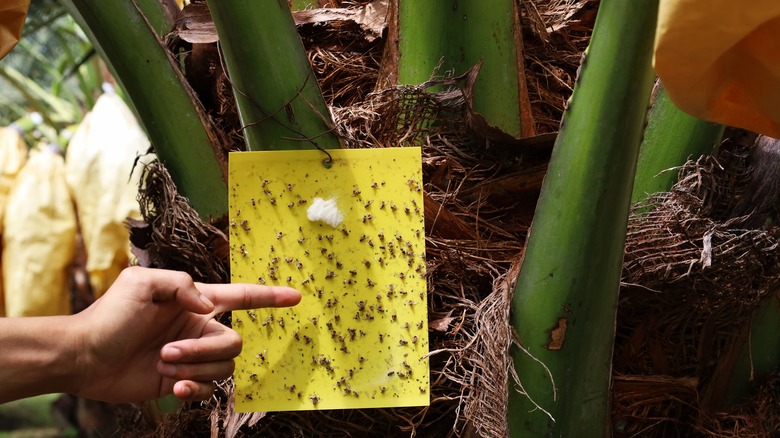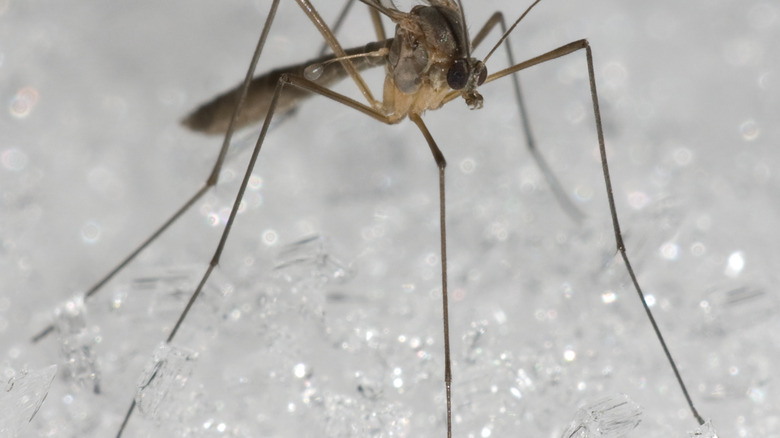Does Freezing Your Potting Soil Really Help Eliminate Fungus Gnats?
Having dark clouds of fungus gnats hovering about your potted plants or billowing upward when you dig into a garden bed is far from pleasant. It's not surprising, then, that the internet is full of exasperated gardeners constantly asking what fungus gnats are and how to get rid of them. Suggestions to freeze them are about as numerous, but is this a legitimate solution to an infestation? Since populations of fungus gnats seem to decline during the colder winter months, at least outdoors, you might think yes. It turns out, however, that the answer is more likely no. These wee beasties are highly resilient, with some species documented as surviving temperatures well below freezing. Plus, who has room in their freezer for bags of potting mix?
There are thousands of fungus gnat species worldwide — all winged insects with thin, dark-colored bodies about one-eighth of an inch long. Some say they look similar to mosquitoes. As the fungus gnat's common name implies, the adults and larvae alike feed on decaying plant material and the fungi that inhabit it. While the adults are mostly harmless to plants and humans, their larvae are a different story, munching their way through roots and sometimes stems. Fungus gnats may also endanger seedlings by spreading plant parasites called Pythium. Adult females lay hundreds of eggs in one go, and since they hatch in a week, they can quickly overtake a plant if conditions are right. And the right conditions include damp, well-mulched, and warm soil.
Masters of cold survival strategies
The fungus gnat lifestyle suggests freezing might work. For example, researchers behind a 2021 paper published in ISHS Acta Horticulturae found that fungus gnat populations naturally decline over the winter months when temperatures drop below 7 degrees Celcius (44.6 degrees Fahrenheit). Craig Everett, OSU Extension Wood County Horticulture Program Assistant, writes in the Sentinel-Tribune that temperatures in the teens would likely kill outdoor gnats — though indoor populations are a different story. Letting greenhouses freeze seasonally is a tried-and-true pest control method, at least for more sensitive bugs. Indeed, National Gardening Association forum member Linneaj suggests freezing then baking potting soil to kill fungus gnats — the former to kill adult insects and the latter to exterminate their eggs.
There is far more evidence to suggest that freezing your soil is not a surefire way to keep pesky gnats away from your houseplants or outdoor garden beds. Fungus gnats are active — for example, eating decaying tree bark — even when snow covers the ground. In 2009, scientists discovered a species of fungus gnat, Exechia nugatoria, that can simultaneously freeze and keep warm different parts of its body to survive extreme winter cold, as published in a Journal of Comparative Physiology B paper. While this doesn't mean all fungus gnat species have this ability (after all, most places in the U.S. don't get down to 60 degrees below Fahrenheit), it demonstrates just how cold-hardy — and resistant to the frozen-soil-as-pest control method — these teeny winged critters are.
How to get rid of fungus gnats
There's no harm in testing freezing to see if it works on whatever gnat species have invaded your soil. First, freeze your potting soil in freezer-proof bags. (You might need to eat through some produce to make room in your freezer.) A 2-inch-thick package takes about two hours or less to freeze solid. Place the still-icy soil in a bucket and pour boiling water over it. Stir the water-soil mixture until all the soil is saturated. Select microbial life — fungi, mold, bacteria, and viruses — goes dormant to survive freezing, though little lives over 212 degrees Fahrenheit. The combination of freezing and superheating covers all bases.
An oft-recommended way to reduce or eliminate fungus gnats from plants is to leave the top layer (to about an inch down) to dry thoroughly between waterings. If the soil is already damp, remove it from the pot and spread it on a baking tray to dry it in the sun, or bake it in the oven at 350 degrees Fahrenheit for 30 minutes. If the infestation is severe, you might have to resort to sticky traps and insecticides. Look for products with bifenthrin, cyfluthrin, permethrin, or lambda-cyhalothrin listed as the active ingredient. If you're not a fan of chemical controls, you could raid your pantry for cinnamon to keep fungus gnats out of your home. A recent experiment with mustard seed meal yielded promising results, too, according to a paper published in the Journal of Applied Entomology.


